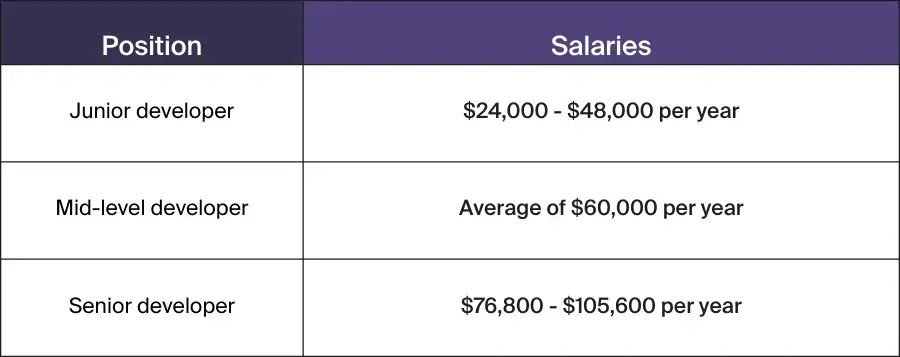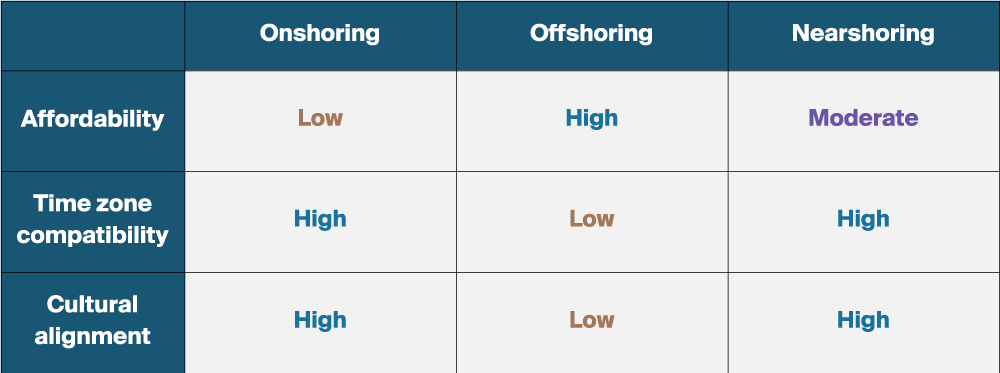Onshore, offshore or nearshore? Analyze which is the best hiring strategy for your business

The tech industry is facing an unprecedented demand for skilled professionals, driven by rapid digital transformation and the ever-growing need for innovation. Businesses often decide whether to hire onshore, offshore, or nearshore talent to navigate these demands.
Each approach offers advantages and disadvantages, so let's explore these perspectives. (Spoiler: Nearshore talent is often the most cost-effective and efficient solution to building a trusted tech team.)
The Rise of IT Nearshoring as a Solution to Industry Challenges
While onshore and offshore hiring have their merits, data shows that nearshore hiring is the most strategic choice for businesses looking to optimize their tech teams. Key developments in education, government initiatives, and global economics are driving the rise of nearshoring as a preferred hiring strategy. The surge in qualified IT professionals makes LATAM an attractive hub of talent ready for international opportunities.
According to the Center for Security and Emerging Technology (CSET), Brazil and Mexico had the highest increase in STEM graduates worldwide between 2015 and 2020. This surge in qualified IT professionals makes the region an attractive hub for companies seeking skilled developers.
Brazil, for instance, has significantly increased its investment in STEM education and innovation in recent years. Government initiatives and programs have fostered the growth of tech hubs, expanded access to quality education, and supported research and development.
Additionally, it's interesting to know that culturally diverse teams are 35% more likely to outperform their peers. Numerous studies have shown that diverse teams can bring a variety of perspectives, problem-solving approaches, and experiences to the table, leading to better decision-making, innovation, and overall performance. Nearshore hiring allows companies to tap into this advantage without the significant cultural gaps that come with offshore teams.
Let's compare nearshoring vs. offshoring vs. hiring locally so you can make an informed decision for your tech team.
Onshore Hiring: Pros and Cons
What is Onshore Hiring?
Onshore hiring is the most classic method of recruiting talent within the same country as your main office. This approach is particularly appealing to companies that prioritize cultural alignment and seamless communication but is also by far the most costly.
Advantages:
- Cultural and Language Alignment: Onshore teams share the same cultural context and language, leading to smoother communication and collaboration. A shared work culture helps team cohesion, communication, and relationship dynamics.
- Time Zone Alignment: With little to no time difference, onshore teams can work simultaneously, allowing real-time collaboration for problem-solving and rapid decision-making.
- Ease of Management: Managing a team located in the same country simplifies logistics and reduces legal complexities since they all operate under the same federal legislation.
Challenges:
- High Costs: Onshore hiring is by far the most expensive option.
- Retention and Competition: The U.S. has the most competitive tech market in the world, leading to low retention rates and the increasing demand for higher salaries and benefits, where you're constantly expected to pay even more.
Affordability breakdown:

Offshore Hiring: Pros and Cons
What is Offshore Hiring?
Offshore hiring refers to recruiting employees from distant countries, often in Asia or Eastern Europe, where labor costs are lower.
Advantages:
- Cost Savings: Offshore hiring has the lower cost for salary expenses within the options.
Challenges:
- Time Zone Differences: With significant time zone gaps, expect your offshore tech team to work opposite hours to your local team. This hinders real-time collaboration, creating communication delays and slowing down project timelines.
- Cultural Barriers: Differences in cultural norms and work ethic often lead to challenges in team integration.
- Quality Concerns: While cost savings are a significant benefit, the quality of work can sometimes be inconsistent, leading to additional management oversight and potential rework.
- Retention: Offshore developers are most reliable for short-term projects because all these challenges lead to high turnover rates.
- Employee Dissatisfaction: Lower costs result in unsatisfied employees, also collaborating for low quality of work and high turnover.
Affordability Breakdown:

Nearshore Hiring: The Best of Both Worlds
What is Nearshore Hiring?
Nearshore hiring is outsourcing work to neighboring or nearby countries within the same or similar time zones. For U.S. companies, this typically means hiring from Latin America.
Advantages:
- Cost-Effective: Nearshore hiring offers a middle ground in terms of cost. It’s more affordable than onshore hiring but comes with fewer risks and challenges than offshore hiring.
- Time Zone Compatibility: A nearshore team works in your time zone, allowing real-time collaboration, minimizing delays, and improving project efficiency.
- Cultural Proximity: Nearshore teams share similar cultural values and business practices, fostering a cohesive work environment.
- High-Quality Talent: Latin America, for example, boasts a growing number of highly skilled developers who are fluent in English and possess strong technical expertise.
- Lower Turnover Rates: The competitive pay makes nearshore hires more satisfied with the company, resulting in a lower turnover rate.
Challenges:
- Higher Costs Than Offshore: While nearshore hiring is more affordable than onshore, it can still be slightly more expensive than offshore.
- Navigating Different Labor Laws: To hire nearshore developers, a company must have the resources to operate under different countries' labor laws. That's why many businesses prefer to partner with a staff augmentation agency rather than hire directly.
Affordability Breakdown:

Why Nearshore Is the Best Choice for Your Company
When considering the balance of cost, quality, and ease of management, nearshore hiring is the most advantageous option for tech companies. Nearshore teams often demonstrate higher levels of accountability and alignment with company goals, boosting financial performance by up to 1.5 times. This option combines a harmonious blend of cost-effectiveness and cultural compatibility that leads to high performance.


How Nearshoring Transformed McGraw Hill's Engineering Team
Our partner McGraw Hill achieved a remarkable 13% year growth in its engineering team, thanks to a strategic shift to nearshoring. By partnering with Jobsity, the company was able to add 25 highly skilled engineers, including a rare Accessibility Engineering Specialist, at 33-50% less cost than their onshore counterparts. This expansion allowed McGraw Hill to accelerate its digital initiatives and meet its ambitious growth goals without breaking the bank.
This success was the result of a focused approach to overcoming the limitations of previous hiring strategies. Initially, McGraw Hill struggled with the high costs of U.S.-based engineers and the communication challenges of offshore teams. By turning to nearshore, McGraw Hill not only resolved the company’s immediate staffing challenges but also positioned itself for long-term success in the competitive ed-tech market.
Ready to Elevate Your Business With Top-tier Nearshore Tech Talent?
Drive your business forward with the right talent—let Jobsity handle the hiring while you focus on growth.
You are our priority. Tell us what you need, and we’ll find the ideal candidate for you. Contact us today to find the perfect fit for your organization and start driving your business toward greater success.
Manoela Caldas is a seasoned copywriter and content expert. With a background that combines Journalism, Media, and Branding, she’s interested in merging in-depth, technical content with digital engagement. Her goal is to create real connections through powerful storytelling. As a knowledgeable and informed professional, Manoela is always attentive to industry news and cultural insights.

